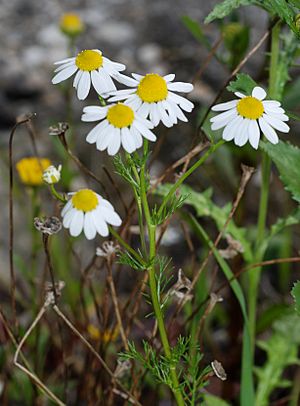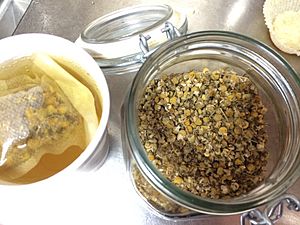Chamomile facts for kids
Chamomile (pronounced KAM-ə-myl or KAM-ə-meel) is the common name for several daisy-like plants. These plants belong to the Asteraceae family, which is a large group of flowering plants. People often use chamomile to make special drinks or other products because of its helpful properties.
For a long time, chamomile has been used for different health reasons. For example, it can help with things like hay fever, swelling in the body, and muscle cramps. It's also used to help people sleep better, calm upset stomachs, and soothe skin problems like eczema or chickenpox. Chamomile is also very special because it is the national flower of Russia.
Contents
What is Chamomile Tea?
Chamomile 'tea' is actually an herbal infusion. This means it's a drink made by steeping dried chamomile flowers in hot water. It's important to know that it's not like regular tea, which comes from the Camellia sinensis plant. Chamomile tea doesn't have caffeine, which is found in black or green teas.
There are two main kinds of chamomile plants used to make this popular drink:
- German chamomile (Matricaria recutita)
- Roman chamomile (Chamaemelum nobile)
Many people find that chamomile tea helps them relax and can be good for their digestion.
How Chamomile Helps Our Bodies
Chamomile has been studied for its health benefits. For example, German chamomile can be used on the skin to help with swelling. It's also known to have properties that can help reduce anxiety and make it easier to fall asleep. This means it might help if you're feeling stressed or having trouble sleeping.
Chamomile in Beauty Products
Chamomile is often found in products you use on your skin. It's added to lotions and creams because it can help make skin soft and smooth. It also has anti-inflammatory effects, which means it can help calm irritated skin. Chamomile is also sometimes used to make blonde hair look brighter.
Chamomile Oil
The oil from German chamomile is used in aromatherapy. This is a practice where people use plant oils to improve their well-being. The oil can be spread into the air using a diffuser. It's also sometimes used to help with minor skin wounds or mixed with other essential oils like lavender and rose for different benefits.
Different Kinds of Chamomile Plants
While many plants have "chamomile" in their name, not all of them are used in the same way as the chamomile used for tea. The two most common types used for tea and other products are:
- Matricaria chamomilla – often called "German chamomile" or "Water of Youth."
- Chamaemelum nobile – also known as Roman, English, or garden chamomile. A special type, C. nobile Treneague, is even used to create a soft, green chamomile lawn.
Here are some other plants that also have "chamomile" in their common name, but are not typically used for tea:
- Anthemis arvensis – corn, scentless, or field chamomile
- Anthemis cotula – stinking chamomile
- Cladanthus mixtus – Moroccan chamomile
- Cota tinctoria – dyer's, golden, oxeye, or yellow chamomile
- Eriocephalus punctulatus – Cape chamomile
- Matricaria discoidea – wild chamomile or pineapple weed
- Tripleurospermum inodorum – wild, scentless, or false chamomile
Images for kids
See also
 In Spanish: Manzanilla (hierba medicinal) para niños
In Spanish: Manzanilla (hierba medicinal) para niños






